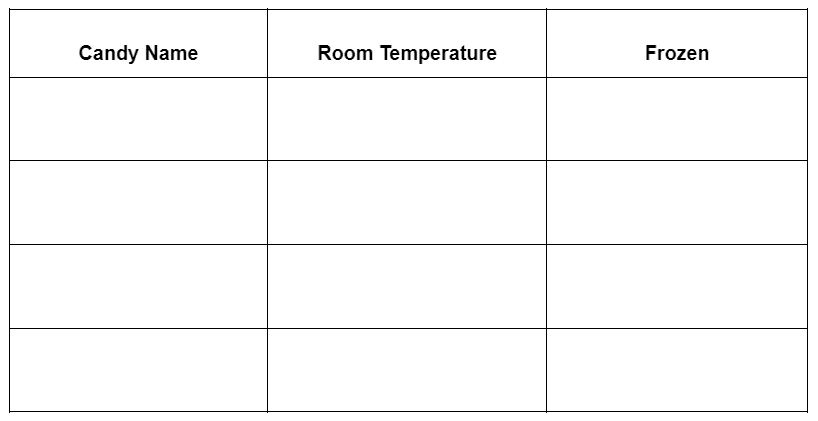Have you ever noticed that different types of food have different textures in your mouth? Some might be hard and crunchy, while others might be soft and chewy. The study of different materials and their properties—like how flexible they are, and how they break—is called Materials Science Engineering.
Real-world materials scientists and engineers try to improve materials that we use to build things, like making stronger metals for buildings and cars, or creating plastics that are easier to recycle and reuse. In this project, you will learn the basics about materials science using tasty (but not necessarily healthy) snacks.
You have probably noticed that some types of food, like a cooked piece of spaghetti or a gummy worm, are very flexible. They are very easy to bend with your hands, and some of them will even bend under their own weight. Materials that maintain their bent shape are called ductiles. Other foods, like pretzel sticks or uncooked pasta, tend to snap or crack very easily when you try to bend them; these materials are called brittle.
Ductile fracture occurs when a material stretches out or bends permanently before it breaks. Imagine bending a paper clip; how far do you have to keep slowly bending the paper clip before it finally breaks? This is ductile fracture.
Brittle fracture occurs when a material bends very little before it breaks. Think about flexing a wooden ruler or pencil. You can bend them slightly and they will spring back to their original shape. However, if you bend them too much, they will instantly break in half. This is brittle fracture
What You Will Need
- 2 Snickers Bars (you can use a 3 Musketeer, Milky Way or other chewy candy bar)
- 2 Airheads, or any chewy taffy type candy
- 6 Gummy worms
- 2 Kit Kat bars (you can use a plain Hershey bar, Butterfinger or other crisp candy bar)
- Freezer
Put half of each type of candy in the freezer overnight and leave the other half out at room temperature. Now you’re ready to test the properties of your four different materials! Use the table provided to keep track of how ductile or brittle each one is using the scale below.
- 1 = Food is totally flexible, very easy to bend with your hands, or bends under its own weight, but does not permanently hold its bent shape.
- 2 = Food is somewhat ductile, you can bend it and it will only partially return to its original shape, and retain some of its bent shape.
- 3 = Food is ductile, you can bend it and it holds the bent shape.
- 4 = Food is somewhat brittle, you can bend it a little bit and it will hold the bent shape. If you bend it too much, it snaps.
- 5 = Food is totally brittle. If you bend it, it will not retain its bent shape at all, and if you bend it too far, it snaps suddenly.

Take one of your room-temperature candy items and hold it on both ends (using both hands). Slowly start to bend it in half. Pay close attention to how hard it is to bend it. Is it very stiff and difficult to bend at all? Is it superflexible and easy to bend?
Continue bending the candy until it breaks. Pay close attention to how it breaks. Does it snap very suddenly (brittle) or does it stretch out and break gradually (ductile)?
Note: Some items, such as Gummi worms, are very flexible, so you might not be able to break them at all by bending them. Can you break them by pulling them apart? If so, how does that break occur—suddenly (brittle) or stretchy and gradually (ductile)?
Now, take the matching candy out of the freezer and repeat the steps above. Remember to carefully observe how the candy breaks. Is the candy easier or harder to bend? Does the candy break in a different way?
Repeat the procedure for each type of your other candy items.
Did the matching candies behave differently depending on their temperatures? How did different candies of the same temperature compare with one another during the bending test? What do you think would happen if you tried bending these candies when they were warmer than room temperature?
Try expanding the project to test more foods. What if you test non-candy items, like pasta, pretzel sticks, or slices of bread? Can you find food items whose flexibility does not appear to depend on temperature? For example, a food that is always ductile, or a food that is always brittle?
This is the sort of experiment that Materials Science Engineers do to find out how materials behave at different temperatures and in different configurations so they can pick the best materials for any given application.
Author
-

SWE Blog provides up-to-date information and news about the Society and how our members are making a difference every day. You’ll find stories about SWE members, engineering, technology, and other STEM-related topics.






